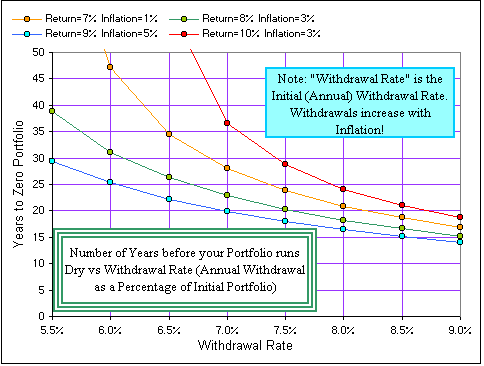At the end of each year we withdraw $P, increasing with inflation,
which we assume is I (I = .03 means 3% annual inflation).
We start with a portfolio worth B and we'll track the balance at the end of each year:
After 1 year our portfolio has grown to B(1+R),
and we withdraw P(1+I).
(See? It's increased ... with inflation!)
Our portfolio is now worth
B(1+R) - P(1+I).
To avoid getting too messy, we'll let
x = (1+R) and
y = (1+I)
so, after ONE year (and ONE withdrawal),
our portfolio is worth
Bx - Py
By the end of the second year this portfolio has increased by a factor x = (1+R) to
Bx2 - Pxy and we withdraw another $P
increased by two years of inflation,
which means we
withdraw Py2,
leaving a portfolio of
Bx2 - P xy - y2.
There's a magic formula we can use here. It's
x2 + xy + y2
= (x3 - y3)/(x - y)
In order to take advantage of this magic formula, we rewrite
the balance in our portfolio as:
(B + P)x2 - P(x2 + xy + y2)
Using the magic formula, it's:
(B + P)x2 - P(x3 - y3)/(x - y)
after TWO years and TWO withdrawals.
We jump ahead to the end of the Nth year.
Your portfolio is now:
(B + P)xN - P(xN+1 - yN+1)/(x - y)
after N years and N withdrawals
(... and we've used that magic formula again ... and again!)
Alas, that last withdrawal left us with a ZERO portfolio:
(B + P)xN - P(xN+1 - yN+1)/(x - y)
= 0.
So what's N, the number of years until our portfolio ran dry?
We suppose (to make life simpler) that we withdraw our first $P at the very start,
so our
original Portfolio is reduced from B to B - P and B+P becomes just B.
We also let z =
x/y = (1+R) / (1+I),
we can rewrite the above equation like so:
| [!] B = P (1 - z-N)/(z - 1) |
| N = -log(1 - (B/P)(z - 1)) / log(z) |
we can compute z = (1+R) / (1+I), hence N.
Here's a calculator to play with:
... and that's also what this spreadsheet does. Just RIGHT-CLICK here and Save Target or Save Link to download.

One more thing:
The Ratio B/P = (1 - Z-N) / (Z - 1) gives a
Magic Multiplier,
namely how large your portfolio should be compared to your desired annual withdrawal (the
withdrawals increasing with inflation). If you want your portfolio to last for thirty years,
you get the following:
For example, if you assume 4.0% inflation and 7.0% return on your investments - both
constant for thirty years after you begin withdrawals
(fat chance!) - then the Magic Multiplier
is
about 20, meaning that if you want $50,000 annually from your portfolio (increasing with
inflation) you should have
20 x $50,000 = $1,000,000 in your portfolio.
P.S. If you want the formula when the first withdrawal is after one year
(instead of immediately), then just replace B by
B + P in [!].
P.P.S. If I = 0 (no "inflation" ... we withdraw equal
amounts at the end of each year),
... ain't Math wunnerful?

* The equation [!] can be rewritten in the form:
z-N = 1 - (B/P)(z - 1)
then take the logarithm of each side.
then y = (1 + I) = 1 so z = x = (1 + R)
If we let also let
interpret R as the monthly rate
(instead of the annual rate),
then (whooee!)
[!] gives the monthly payments,
$P, for
an N-month mortgage of amount $B:
P = BR / (1 - (1+R)-N)
Okay, all the above assumes a constant rate of return. Does that really happen,
in real life? Hardly. To get some idea of what could happen with REAL investments, where the
gain increases, decreases, is larger, then smaller, sometimes positive, sometimes negative ...
see Portfolio Growth.
